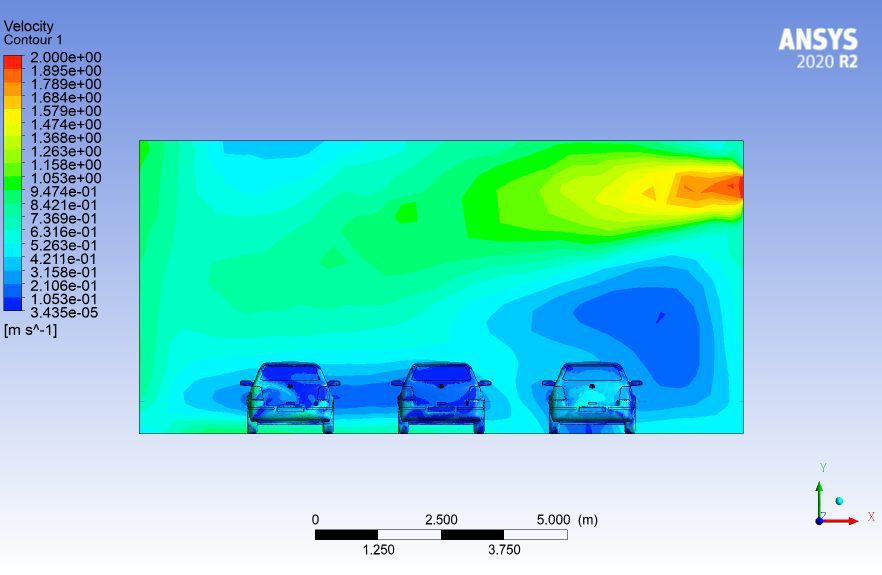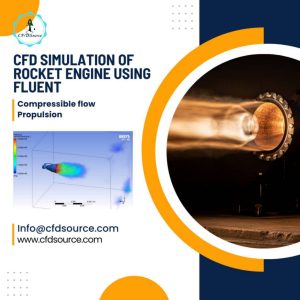applications of CFD: Computational Fluid Dynamics (CFD) serves as a technological marvel, allowing engineers and scientists to delve into the intricate world of fluid flows. At its core, CFD is a discipline that employs numerical methods and algorithms to simulate the behavior of fluids, be it liquids or gases. It’s the digital wind tunnel that aids in comprehending the complex dynamics of airflow, heat transfer, and other fluid-related phenomena.
Imagine having the ability to visualize the invisible, to watch how air moves around an aircraft wing or how heat dissipates within an electronic device. CFD provides this capability, offering insights that were once confined to theoretical studies and physical experiments. This understanding is fundamental for advancements in various industries, making CFD an indispensable tool for engineers seeking to optimize designs, improve efficiency, and push the boundaries of innovation.

Applications of CFD in Aerospace
In the realm of aerospace engineering, the applications of Computational Fluid Dynamics (CFD) are nothing short of revolutionary. Aircraft design and optimization, two critical aspects of aerospace engineering, benefit immensely from CFD simulations. Engineers can now virtually test and refine aerodynamic designs, minimizing the need for costly and time-consuming physical prototypes. Whether it’s understanding the airflow over the wings or predicting the impact of different components on drag, CFD plays a pivotal role in shaping the future of aviation.
The ability to optimize fuel efficiency and overall performance is a game-changer, allowing for the development of aircraft that are not only safer but also more environmentally friendly. As aerospace technology continues to evolve, so does the reliance on CFD for pushing the boundaries of what’s possible in the skies.
CFD in Automotive Engineering
Automotive engineering embraces the power of Computational Fluid Dynamics (CFD) to enhance vehicle design and performance. The aerodynamics of a car significantly influence fuel efficiency and overall drivability. CFD simulations enable engineers to study the airflow around a vehicle, identifying areas of drag and lift. This information is invaluable in designing cars that cut through the air with minimal resistance, leading to improved fuel economy and increased stability.
Beyond aerodynamics, CFD is instrumental in optimizing engine cooling systems. Efficient cooling is crucial for preventing engines from overheating and ensuring they operate at peak efficiency. With CFD, engineers can fine-tune the design of cooling systems, balancing airflow and temperature to guarantee optimal engine performance and longevity.
CFD in Renewable Energy
The application of Computational Fluid Dynamics (CFD) in the realm of renewable energy is a testament to its versatility. In the design and optimization of wind turbines, CFD simulations play a crucial role. Engineers use these simulations to understand the aerodynamics of turbine blades, ensuring they capture maximum wind energy. This not only improves the efficiency of individual turbines but also contributes to the larger goal of harnessing wind power for sustainable energy production. Similarly, in the solar energy sector, CFD aids in optimizing the placement and design of solar panels. By analyzing sunlight exposure and heat distribution, engineers can strategically position solar panels to capture the maximum amount of sunlight, increasing overall energy output. The intersection of CFD and renewable energy is paving the way for a greener and more sustainable future.

Medical Applications of CFD
In the field of medicine, Computational Fluid Dynamics (CFD) has emerged as a powerful tool for simulating and understanding complex biological processes. One prominent application lies in the simulation of blood flow within the human body. CFD allows researchers and medical professionals to model the dynamics of blood circulation, identifying potential issues such as blockages or irregularities. These simulations aid in diagnosing cardiovascular conditions and planning interventions with a level of precision that was previously unimaginable.
Furthermore, CFD is instrumental in respiratory system studies, providing insights into airflow patterns and gas exchange within the lungs. This has profound implications for designing ventilators and understanding respiratory diseases. The marriage of CFD and medicine exemplifies how cutting-edge technology can revolutionize healthcare, offering new avenues for diagnosis, treatment, and research.
CFD in Electronics Cooling
As electronic devices become increasingly sophisticated and compact, efficient thermal management is paramount to ensure their optimal performance and longevity. Computational Fluid Dynamics (CFD) has become an indispensable tool in the electronics industry for designing effective cooling systems. By simulating the heat dissipation within electronic devices, engineers can identify potential hotspots and optimize cooling solutions.
This is particularly crucial in the design of modern electronic gadgets, where components are densely packed, and heat generation is substantial. CFD helps in fine-tuning the layout of Printed Circuit Boards (PCBs) to ensure uniform temperature distribution and prevent overheating. The ability to predict and manage thermal issues through CFD not only enhances the reliability of electronic devices but also contributes to the development of more energy-efficient technologies, aligning with the global push towards sustainability.
Challenges in CFD
While Computational Fluid Dynamics (CFD) has revolutionized engineering and scientific simulations, it is not without its challenges. One of the primary concerns is the accuracy of simulations. Achieving a high level of accuracy requires precise input data and complex numerical models, and even then, real-world conditions may introduce uncertainties. Striking a balance between computational efficiency and accuracy is an ongoing challenge.
Additionally, the computational resources required for intricate simulations can be substantial. High-fidelity simulations demand significant processing power, limiting accessibility for smaller organizations or educational institutions with budget constraints. Addressing these challenges involves ongoing research and development to refine algorithms, improve simulation methodologies, and make CFD more accessible to a broader audience.

Recent Innovations in CFD
The landscape of Computational Fluid Dynamics (CFD) is continually evolving, and recent innovations have propelled this field into new frontiers. One notable advancement is the integration of machine learning techniques into CFD simulations. Machine learning algorithms enhance the accuracy and efficiency of simulations by learning from vast datasets and adapting to complex fluid dynamics scenarios. This synergy between CFD and machine learning has opened avenues for real-time simulations, where the system can adapt and evolve based on dynamic inputs.
The result is simulations that not only provide more accurate predictions but also respond dynamically to changes in the simulated environment. As technology advances, these innovations hold promise for more widespread and accessible use of CFD across diverse industries, pushing the boundaries of what is achievable in fluid dynamics simulations.
Future Prospects of CFD
The future of Computational Fluid Dynamics (CFD) holds exciting prospects, with anticipated advancements poised to further elevate its impact across various industries. One of the key areas of development is the refinement of simulation accuracy. Ongoing research aims to enhance the precision of CFD models, making them more representative of real-world conditions. This increased accuracy is crucial for applications such as aerospace design, where small discrepancies can have significant consequences.
Additionally, the user interface and accessibility of CFD software are expected to improve, allowing engineers and researchers with diverse backgrounds to harness the power of CFD without extensive computational expertise. As advancements continue, CFD is likely to play an even more integral role in shaping the design and optimization processes, contributing to the development of safer, more efficient, and environmentally friendly technologies.
Case Studies
Examining real-world Case Studies showcases the tangible impact of Computational Fluid Dynamics (CFD) on product development and problem-solving within various industries. For instance, in the automotive sector, CFD simulations have been instrumental in optimizing the design of Formula 1 cars. Engineers use CFD to analyze airflow around the vehicle, ensuring maximum aerodynamic efficiency and performance on the racetrack. In the aerospace industry, CFD has played a pivotal role in the design of fuel-efficient and environmentally friendly aircraft. These case studies highlight how CFD is not just a theoretical tool but a practical solution that translates into tangible improvements in product design, efficiency, and safety across diverse engineering disciplines.
CFD Software Comparison
Choosing the right Computational Fluid Dynamics (CFD) software is a critical decision for engineers and researchers. A comprehensive CFD Software Comparison is essential to understand the strengths, limitations, and suitability of different tools for specific applications. Popular CFD software includes ANSYS Fluent, OpenFOAM, and COMSOL Multiphysics, each offering unique features and capabilities. ANSYS Fluent, for example, is known for its versatility in handling complex fluid dynamics problems, while OpenFOAM, being open-source, appeals to a community of developers and researchers.
COMSOL Multiphysics stands out for its multiphysics simulation capabilities, allowing the coupling of fluid dynamics with other physical phenomena. The choice of software depends on factors such as the complexity of simulations, user interface preferences, and the specific needs of the application. A thoughtful CFD software comparison enables engineers to make informed decisions, ensuring the selected tool aligns with the objectives of their simulations.
CFD and Environmental Impact
The intersection of Computational Fluid Dynamics (CFD) and environmental sustainability is a topic of increasing relevance. As industries strive to reduce their carbon footprint, CFD plays a pivotal role in designing environmentally friendly solutions. Through simulations, engineers can optimize processes to minimize energy consumption, improve the efficiency of renewable energy systems, and design products with reduced environmental impact.
In the automotive sector, CFD contributes to the development of electric vehicles by optimizing battery cooling systems and improving overall aerodynamics. Furthermore, CFD aids in the design of energy-efficient buildings by optimizing airflow for natural ventilation and reducing the need for artificial cooling or heating. The potential for CFD to contribute to sustainable practices makes it a key player in the global efforts towards a greener and more eco-friendly future.
Educational and Research Use of CFD
Beyond its applications in industries, Computational Fluid Dynamics (CFD) serves as a valuable tool in education and research. In academic settings, CFD simulations provide students with a hands-on approach to understanding fluid dynamics principles. Educational institutions use CFD software to teach engineering and physics students how to model and analyze fluid flows. This practical experience enhances students’ understanding of theoretical concepts and prepares them for real-world applications.
Moreover, CFD plays a crucial role in research projects, enabling scientists and engineers to explore complex fluid dynamics phenomena. Collaborative research endeavors leverage CFD to simulate and understand fluid behaviors in areas such as environmental science, biofluid dynamics, and climate modeling. The educational and research use of CFD not only contributes to the development of skilled professionals but also advances our understanding of fundamental scientific principles.
Conclusion
applications of CFD: In conclusion, Computational Fluid Dynamics (CFD) stands as a transformative force, revolutionizing how we approach engineering, design, and scientific research. Its diverse applications, from optimizing aerodynamics in aerospace to simulating blood flow in medical research, showcase the versatility and significance of CFD across various domains. As technology advances, the future prospects of CFD are promising, with anticipated improvements in simulation accuracy and accessibility. Real-world case studies emphasize the tangible impact of CFD on product development and problem-solving, reinforcing its practical value.
The comparison of CFD software underscores the importance of choosing the right tool for specific applications, ensuring optimal outcomes. CFD’s role in addressing environmental challenges aligns with the global push towards sustainability, making it an integral part of eco-conscious practices. In educational and research settings, CFD fosters a deeper understanding of fluid dynamics principles and contributes to groundbreaking discoveries. In essence, the journey through the intricacies of CFD reveals a world where digital simulations shape the future of innovation and scientific exploration.



